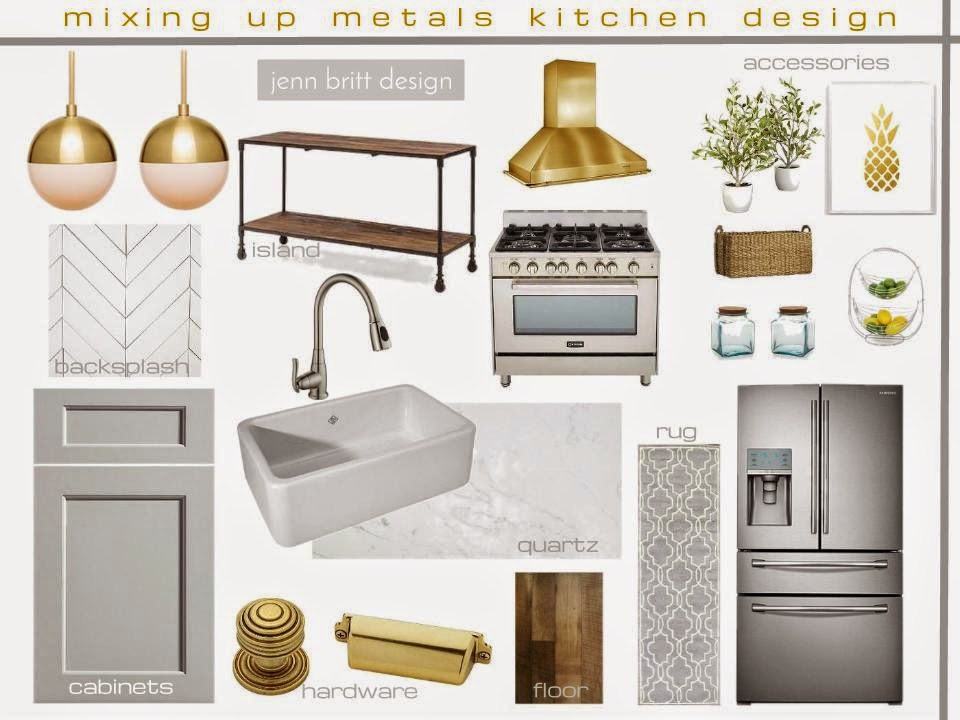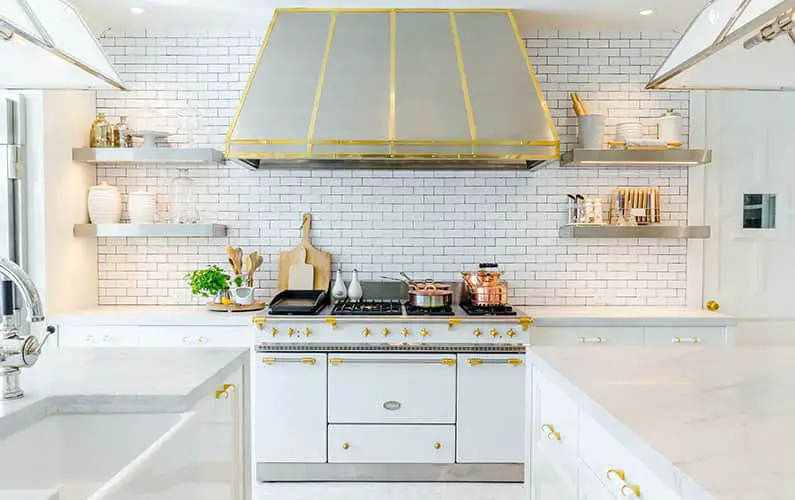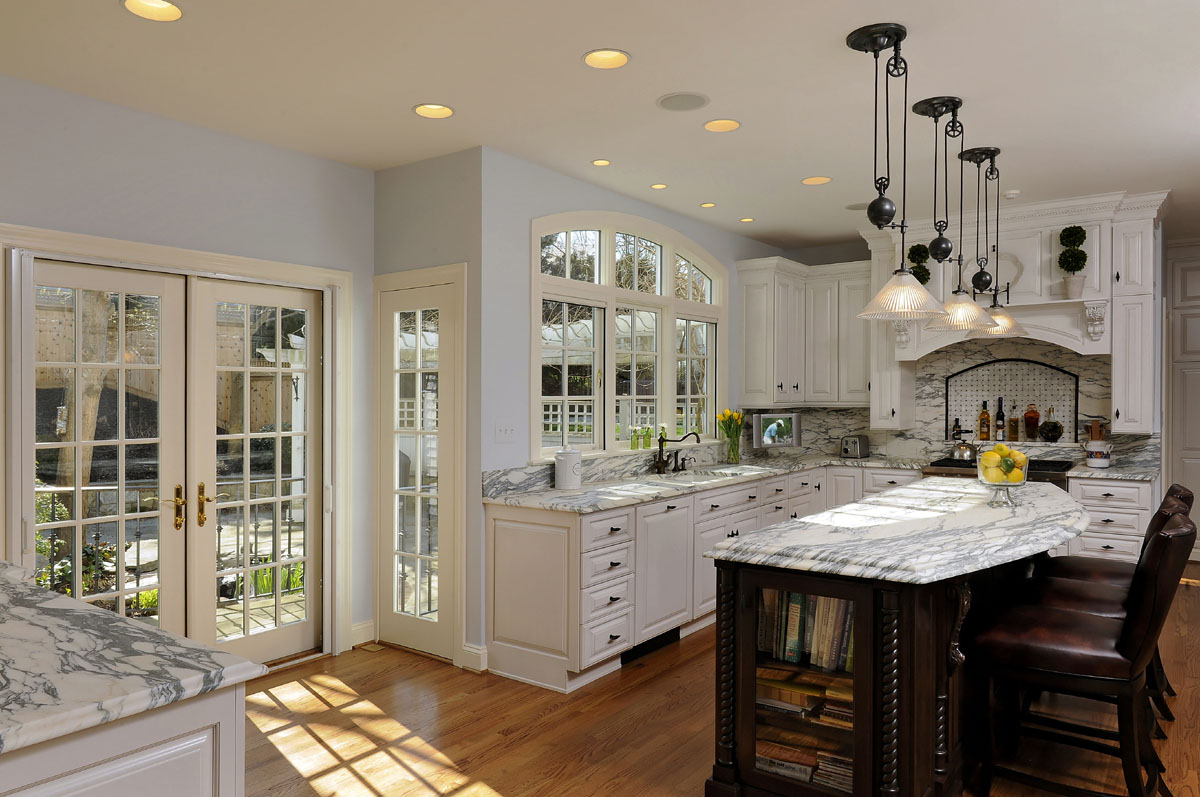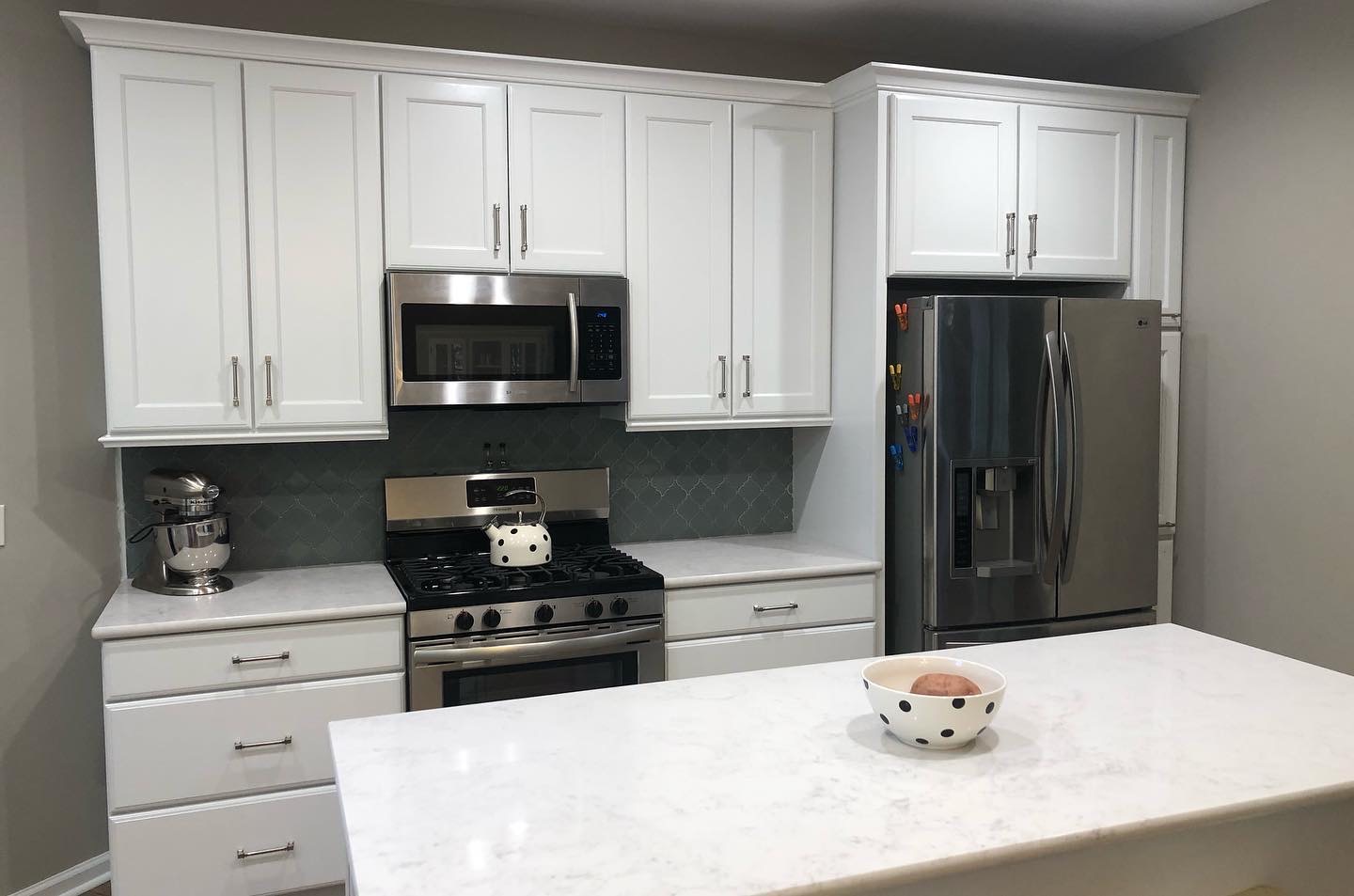The use of mixed metals in kitchen design has become increasingly popular in recent years, and for good reason. It adds a unique and modern touch to any kitchen, elevating the overall design and creating a one-of-a-kind look. But mixing metals can be tricky and overwhelming if not done correctly. So, how do you mix and match metals in your kitchen to create a cohesive and stylish look? Metallic Finishes: The first step in mixing metals in kitchen design is to understand the different metallic finishes. The most common finishes used in kitchen design are polished, brushed, and matte. Polished finishes have a shiny and reflective surface, while brushed finishes have a more subdued and textured look. Matte finishes have a smooth and non-reflective surface. Understanding the different finishes will help you create a balanced and cohesive look in your kitchen. Choose a Dominant Metal: When mixing metals, it's important to choose a dominant metal to serve as the foundation of your design. This metal will be the main focus and should be used in larger elements such as appliances, hardware, and fixtures. For example, if you choose stainless steel as your dominant metal, use it for your refrigerator, oven, and sink faucet. Add Complementary Metals: Once you have chosen your dominant metal, it's time to add complementary metals. These metals will add depth and interest to your design. For example, if your dominant metal is stainless steel, you can complement it with brushed nickel or copper. Just remember to stick to one or two complementary metals to avoid overwhelming the space. Don't Be Afraid to Mix Colors: Mixing metals doesn't mean you have to stick to one color. You can mix different colored metals, such as silver and gold, to add visual interest and create a unique look. However, make sure to keep the finishes consistent. For example, if you mix silver and gold, make sure they both have a polished or brushed finish. Consider the Style of Your Kitchen: When choosing which metals to mix, consider the style of your kitchen. If you have a modern kitchen, mixing metals with clean lines and sleek finishes will complement the design. For a more traditional kitchen, mix metals with more intricate designs and warmer finishes. Balance is Key: The key to successful mixing of metals is balance. Make sure to distribute the different metals evenly throughout the space. If you have a lot of stainless steel in your kitchen, balance it out with some warm-toned metals like copper or gold. This will create a harmonious and well-rounded look.1. Mixed Metals in Kitchen Design: How to Mix and Match Metals in Your Kitchen
If you're looking to incorporate mixed metals into your kitchen design, here are 10 ideas to inspire you and help you create a bold and beautiful space: 1. Two-Toned Cabinets: One way to mix metals in your kitchen is to have two-toned cabinets with different colored handles. For example, you can have silver handles on your top cabinets and gold handles on your bottom cabinets. This will add visual interest and break up the monotony of one color. 2. Mixed Metal Backsplash: Instead of sticking to one type of metal for your backsplash, mix it up with a combination of different metals. You can have a mix of stainless steel, copper, and gold tiles to create a unique and eye-catching design. 3. Contrasting Hardware: Add a pop of contrast to your kitchen design by using hardware in a different metal than your cabinets. For example, if your cabinets are in a brushed nickel finish, use gold or copper hardware for a touch of warmth and character. 4. Blended Fixtures: For a more subtle approach, mix metals in your kitchen fixtures. You can have a stainless steel sink with a copper faucet or a gold light fixture above your stainless steel island. This will add dimension and interest without overwhelming the space. 5. Dual-Toned Appliances: Make a statement in your kitchen by selecting appliances in two different metal finishes. For example, you can have a stainless steel refrigerator and a brushed copper oven. This will create a unique and eclectic look in your kitchen. 6. Mixed Metal Accents: Another way to incorporate mixed metals is through accent pieces such as bar stools, pendant lights, or decorative objects. Mixing different metals in these small accents will add a touch of interest and personality to your kitchen design. 7. Contrasting Countertops: If you have a kitchen island, consider having a different metal for the countertop. For example, if your main countertops are in a stainless steel finish, you can have a copper or bronze countertop for your island. This will create a striking contrast and add visual interest to your kitchen. 8. Mixed Metal Range Hood: Make a statement in your kitchen by incorporating a mixed metal range hood. This will not only serve as a functional piece but also add a touch of character and style to your kitchen design. 9. Gold Accented Hardware: For a touch of glam and luxury, consider using gold accents in your kitchen hardware. You can have gold handles on your cabinets or gold knobs on your drawers to add a touch of elegance and sophistication. 10. Metallic Wall Art: Another way to incorporate mixed metals is through wall art. You can have a combination of different metal frames or artwork with metallic accents to add a touch of shine and texture to your kitchen walls.2. 10 Mixed Metal Kitchen Ideas for a Bold and Beautiful Design
While mixing metals in kitchen design can add a unique and modern touch to your space, there are some dos and don'ts to keep in mind to ensure a successful and cohesive look: Do: • Do choose a dominant metal to serve as the foundation of your design. • Do add complementary metals to add depth and interest. • Do consider the style of your kitchen when choosing which metals to mix. • Do balance the different metals throughout the space. Don't: • Don't mix too many different metals, stick to one or two complementary metals. • Don't mix warm and cool tones, stick to one color temperature. • Don't mix finishes within the same metal, stick to one type of finish for a cohesive look. • Don't forget to consider the overall design and style of your kitchen when mixing metals.3. The Dos and Don'ts of Mixing Metals in Kitchen Design
Mixing metals in kitchen design can add a unique and modern touch, but it's important to create a cohesive look to avoid overwhelming the space. Here are some tips for creating a cohesive look with mixed metals: Stick to a Color Scheme: To create a cohesive look, stick to a color scheme when mixing metals. Choose warm-toned metals such as gold, copper, and brass or cool-toned metals such as silver, stainless steel, and chrome. This will create a unified and harmonious look in your kitchen. Use a Variety of Finishes: While sticking to a color scheme, you can still mix different finishes to add texture and interest. For example, you can mix a polished stainless steel with a brushed gold for a dynamic and cohesive look. Repeat Metals Throughout the Space: Another way to create a cohesive look is to repeat the use of certain metals throughout the space. For example, if you have gold hardware on your cabinets, you can also have a gold light fixture or a gold-framed mirror on the wall. This will tie the different elements together and create a cohesive look. Balance Warm and Cool Tones: If you're mixing both warm and cool-toned metals, make sure to balance them out. For example, if you have a lot of gold accents, balance it out with some silver or stainless steel elements to create a well-rounded look.4. Creating a Cohesive Look with Mixed Metals in Kitchen Design
Mixing metals in kitchen design is a great way to add a trendy twist to a traditional kitchen. By incorporating different metals, you can elevate the overall design and create a unique and modern look. Here are some tips for mixing metals in a traditional kitchen: Start Small: If you're hesitant about mixing metals in a traditional kitchen, start small. You can begin by incorporating mixed metal accents such as bar stools, light fixtures, or hardware. This will add a touch of interest and modernity without overwhelming the traditional design. Mix Warm and Cool Tones: Traditional kitchens tend to have warmer tones, so mixing in some cooler-toned metals can add a touch of contrast and modernity. You can mix gold, copper, and brass with silver, stainless steel, and chrome for a balanced and stylish look. Consider the Overall Design: When mixing metals in a traditional kitchen, it's important to consider the overall design. Stick to a cohesive color scheme and choose metals that complement the traditional elements in your kitchen, such as wood cabinets or a farmhouse sink. Don't Be Afraid to Be Bold: Mixing metals in a traditional kitchen is all about creating a balance between traditional and modern elements. Don't be afraid to be bold and mix in some unexpected metals, such as a copper range hood or a silver backsplash. This will add a touch of personality and uniqueness to your traditional kitchen.5. Mixing Metals: A Trendy Twist on Traditional Kitchen Design
Blending metals in kitchen design is a great way to create a cohesive and harmonious look. Blending metals involves using different metals within the same color family to create a seamless and unified look. Here are some tips for blending metals in your kitchen: Choose a Dominant Metal: Just like mixing metals, blending metals also involves choosing a dominant metal to serve as the foundation of your design. This metal will be used in larger elements such as appliances, hardware, and fixtures. Choose Complementary Metals: Instead of using contrasting metals, choose complementary metals within the same color family. For example, if your dominant metal is brushed nickel, you can use brushed stainless steel or brushed chrome as complementary metals. Use Different Finishes: To create dimension and interest, use different finishes within the same color family. For example, you can use polished and brushed finishes of the same metal to add texture and variety to your design. Repeat Metals Throughout the Space: To create a cohesive look, make sure to repeat the same metals throughout the space. This will tie the different elements together and create a unified look.6. The Beauty of Blending Metals in Kitchen Design
If you're ready to incorporate mixed metals into your kitchen design, here are some tips to help you get started: Start with Small Accents: If you're new to mixing metals, start with small accents such as bar stools, light fixtures, or hardware. This will allow you to experiment and get a feel for how the different metals look together before committing to larger elements. Choose a Dominant Metal: As mentioned before, it's important to choose a dominant metal to serve as the foundation of your design. This will help guide your decisions and create a cohesive look. Consider Your Existing Elements: When incorporating mixed metals, consider the existing elements in your kitchen such as cabinets, countertops, and flooring. Choose metals that complement these elements to create a harmonious look. Stick to a Color Scheme: To avoid a chaotic and overwhelming look, stick to a color scheme when mixing metals. Choose warm or cool tones and stick to one or two complementary metals.7. How to Incorporate Mixed Metals into Your Kitchen Design
If you want to create a modern and chic kitchen design, mixing metals is the way to go. Here are some tips to help you achieve a modern and stylish look with mixed metals: Choose Sleek and Clean Lines: When mixing metals in a modern kitchen, stick to sleek and clean lines. This will complement the modern design and create a cohesive look. Play with Contrasting Finishes: Mixing metals in a modern kitchen is all about creating contrast and interest. Play with different finishes such as polished and brushed to add dimension and texture to your design. Don't Be Afraid to Mix Colors: In a modern kitchen, don't be afraid to mix different colored metals. You can mix silver and gold or black and copper to add a touch of personality and uniqueness to your space. Keep the Color Palette Simple: To maintain a modern and chic look, keep the color palette simple. Stick to one or two main colors and use metals to add pops of interest and contrast.8. Mixing Metals: The Secret to a Modern and Chic Kitchen Design
9. Bold and Beautiful: Using Mixed Metals to Elevate Your Kitchen Design
Mixing Metals in Kitchen Design: A Modern and Versatile Trend

Why Mixed Metals are Gaining Popularity in Kitchen Design
 The use of mixed metals in kitchen design has become increasingly popular in recent years. This trend has emerged as a way to add dimension, depth, and visual interest to kitchen spaces. Mixing different metal finishes, such as
gold
,
silver
, and
bronze
, allows for a modern and versatile look that can complement any style of kitchen.
The use of mixed metals in kitchen design has become increasingly popular in recent years. This trend has emerged as a way to add dimension, depth, and visual interest to kitchen spaces. Mixing different metal finishes, such as
gold
,
silver
, and
bronze
, allows for a modern and versatile look that can complement any style of kitchen.
The Beauty of Contrasting Metals
 One of the main reasons why mixed metals are gaining popularity in kitchen design is the beauty of contrasting finishes. The combination of different metals creates a striking visual effect that can add character and personality to any kitchen. For example, pairing a
polished chrome
faucet with
brass
cabinet hardware can create a stunning contrast that adds a touch of elegance and sophistication to the space.
One of the main reasons why mixed metals are gaining popularity in kitchen design is the beauty of contrasting finishes. The combination of different metals creates a striking visual effect that can add character and personality to any kitchen. For example, pairing a
polished chrome
faucet with
brass
cabinet hardware can create a stunning contrast that adds a touch of elegance and sophistication to the space.
Creating a Cohesive Look
 Another reason why mixing metals in kitchen design is becoming a popular trend is its ability to create a cohesive look. Instead of sticking to one metal finish throughout the kitchen, incorporating different finishes can tie the space together and create a harmonious design. For example, using
copper
pendant lights over an
oil-rubbed bronze
kitchen island can create a cohesive and well-designed look.
Another reason why mixing metals in kitchen design is becoming a popular trend is its ability to create a cohesive look. Instead of sticking to one metal finish throughout the kitchen, incorporating different finishes can tie the space together and create a harmonious design. For example, using
copper
pendant lights over an
oil-rubbed bronze
kitchen island can create a cohesive and well-designed look.
Adding Texture and Depth
 Mixing metals in kitchen design also allows for the incorporation of different textures and depths. For instance, combining a
brushed nickel
backsplash with
antique brass
cabinet handles can add visual interest and create a more dynamic space. This can be particularly useful in kitchens with a neutral color palette, as it can prevent the space from looking too bland or one-dimensional.
Mixing metals in kitchen design also allows for the incorporation of different textures and depths. For instance, combining a
brushed nickel
backsplash with
antique brass
cabinet handles can add visual interest and create a more dynamic space. This can be particularly useful in kitchens with a neutral color palette, as it can prevent the space from looking too bland or one-dimensional.
The Versatility of Mixed Metals
 One of the biggest advantages of incorporating mixed metals in kitchen design is its versatility. This trend can be applied to various styles of kitchens, from modern and sleek to traditional and rustic. It also allows for endless possibilities and combinations, making it easy to find the perfect mix of metals that suits your personal style and design preferences.
One of the biggest advantages of incorporating mixed metals in kitchen design is its versatility. This trend can be applied to various styles of kitchens, from modern and sleek to traditional and rustic. It also allows for endless possibilities and combinations, making it easy to find the perfect mix of metals that suits your personal style and design preferences.
Final Thoughts
 In conclusion, mixing metals in kitchen design is a trend that is here to stay. It offers a unique and modern look that can add character, texture, and depth to any kitchen space. With its ability to create a cohesive and versatile design, it's no wonder that more and more homeowners are opting to incorporate mixed metals into their kitchen remodels. So, if you're looking to add a touch of style and sophistication to your kitchen, consider mixing metals for a truly stunning and on-trend result.
In conclusion, mixing metals in kitchen design is a trend that is here to stay. It offers a unique and modern look that can add character, texture, and depth to any kitchen space. With its ability to create a cohesive and versatile design, it's no wonder that more and more homeowners are opting to incorporate mixed metals into their kitchen remodels. So, if you're looking to add a touch of style and sophistication to your kitchen, consider mixing metals for a truly stunning and on-trend result.




:max_bytes(150000):strip_icc()/high_res-1-835e8fdf10254d1eb40e444f2bff0df3.jpg)
:max_bytes(150000):strip_icc()/3_mixed_metals_2227501_2013h071-1-15960b15212846c9bb6dd46820ee6396.jpg)









/light-blue-modern-kitchen-CWYoBOsD4ZBBskUnZQSE-l-97a7f42f4c16473a83cd8bc8a78b673a.jpg)





















































